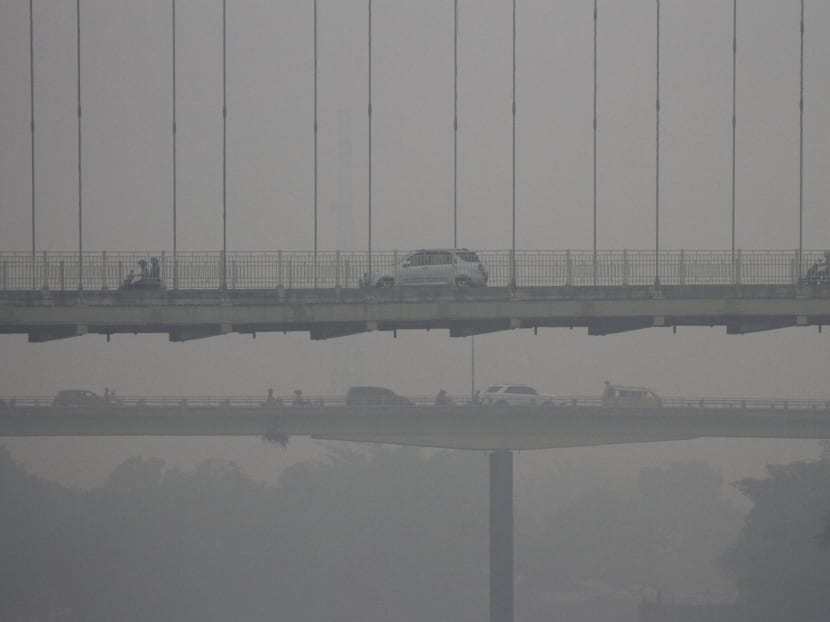Impact from Indonesia’s toxic smoke outweighs agriculture benefits, say scientists
KUALA LUMPUR – The smoke caused by Indonesia’s forest fires are a toxic cocktail of gases ranging from cyanide to ammonia, scientists studying the smog in Palangka Raya, Indonesia have discovered.

Vehicles drive along Siak Bridge, shrouded by haze, in Pekanbaru, Indonesia's Riau province on Oct 11, 2015. Photo: Reuters
KUALA LUMPUR – The smoke caused by Indonesia’s forest fires are a toxic cocktail of gases ranging from cyanide to ammonia, scientists studying the smog in Palangka Raya, Indonesia have discovered.
Additionally, the impact of the fires, used to conduct land clearing for agricultural expansion, on health and biodiversity will outweigh the benefits of opening up more land for planting, a scientist with the Center for International Forestry Research (Cifor) said.
Cifor reported on its blog recently that researchers fear the effects of Indonesia’s fires may be worse than anticipated, going by the levels of hazardous gases measured from the smoke during a workshop there.
Cifor said the scientists have identified ozone, carbon monoxide, cyanide, ammonia and formaldehyde in the smoke, which is spreading across the Asean region, forcing schools in Malaysia to close down for several days.
Cifor’s director of Forests and Environment Louis Verchot said the economic impact of the fires would far outweigh the benefits of expanding agricultural land.
“When you take into account the health impacts, when you take into the account the impacts on biodiversity, when you take into account the impacts on the land – they are going to far outweigh the benefits of expanding agricultural land,” he said in the Cifor report.
King’s College London’s Professor of Earth Observation Science Martin Wooster said carbon monoxide measurements normally register under one part per million (ppm), but in Central Kalimantan was seeing measurements of 30 ppm.
“I’ve visited quite a few sites of biomass burning during my 10 years or so of research in the area.
“And I can certainly say this is the worst situation I’ve ever encountered for biomass burning or any form of combustion in a natural environment,” Prof Wooster was quoted as saying in the report.
Prof Wooster was among the scientists who participated in the workshop in Palangka Raya in mid-October.
Students in the workshop learned how to measure the impact of the fires on the atmosphere, including quantifying the levels of gas and smoke particles in the air to understand the smog’s impact on human health, said Cifor.
The scientists believe that the data they are uncovering, including the real levels of carbon dioxide and methane gas in the smoke, will help the government deal with the problem.
Another study led by a Dutch scientist recently revealed that Indonesia’s forest fires emitted more greenhouse gases than average daily emissions by the entire US economy.
In a separate statement, senior consultant paediatrician Dr Amar-Singh HSS said N95 masks were the most effective means of protecting oneself from the smoke, but only if worn correctly and of a proper fit.
He cautioned that normal surgical masks were ineffective in filtering out harmful substances inherent in the smoke.
“The single-ply surgical masks (usually white) are ineffective. The usual three-ply surgical masks (usually green or blue and thicker) also cannot filter these fine particles.
“It may offer some protection against larger particles that irritate, hence may be useful for some exposure outdoors, on a bike, etc,” said Dr Amar-Singh.
He said a study published by the British Medical Journal also warned against using cloth masks, as “penetration of cloth masks by particles was almost 97 per cent compared to 44 per cent with medical masks (three-ply)”.
He added that more detailed study was needed to gauge the effectiveness of air conditioners and air purifiers given the various brands in the market, each with different filtration systems. THE MALAYSIAN INSIDER






